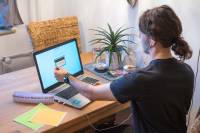Inhaltsverzeichnis
Conducting Remote Reading Studies
Finding ways to conduct remote reading studies under standardised conditions

Members: Laura Zeilbeck, Tanja Gehr
Keywords: remote reading, comparable study, paper, digital documents, study design
Conducting Remote Reading Studies
Background
A large number of studies have already investigated the influence of the medium (usually paper vs. computer display) on reading behavior. However, the results are not clear. Sometimes paper is „better“, sometimes the display. Probably this may be due to the fact that in some studies the advantages of paper (e.g. contrast, mobility) are more important and in others the advantages of displays (e.g. brightness) are. Unfortunately, these differences have not been systematically investigated or controlled in most studies to date. In order to determine more precisely which properties of the media support or hinder reading, a study design was developed within the framework of two final theses (Hebeisen, M. (2020) „Einflüsse verschiedener Textmedien auf das Leseverhalten“ and Sautmann, M. (2020) „Einfluss von Technologie und Größe verschiedener Anzeigemedien auf das Leseverhalten“) that controls as many influencing factors as possible so that all the media examined perform equally well. Based on this study design, it is now possible to make specific changes and see whether these have an influence on reading behavior (e.g., different font sizes). On the other hand, this study design can be used to determine whether there are any unknown disturbing variables. If the study is conducted and one medium performs significantly better than the others, there seem to be some influences that favor this medium (e.g., differences in ambient light).
Due to the COVID-19 pandemic, laboratory studies on reading behavior are difficult to implement and otherwise very costly.
Remote studies, in which the test participants read given texts at home, however, provide data that can be evaluated more difficult, since there are many more influencing factors that differ in each home.
Goals
The project aims to find out which factors have an influence on a reading study at home and how these can be controlled well.
For this purpose, it must first be investigated which interfering variables occur in remote studies. Suitable control mechanisms must then be developed. The aim is that the different environmental conditions in remote studies are either controlled or measured. Readers should therefore perform similarly well when reading the same texts on the same medium, regardless of where the study is conducted.
In a summative study it should be shown that the control mechanisms and the study design ensure comparable results.
Possible Tasks
- Reproducing the study design of M. Sautmann
- Literature research on remote studies and reading studies
- Conducting a remote pilot study to find out which confounding variables exist
- Conducting a remote study to find out how the interfering variables can be controlled or measured
- Remote Summative Study to demonstrate how comparable results are in different environments
First Pilot study and kick-off study (2021-01-08)
Short overview to first pilot study and kick-off action for our study (more...)
Roadmap (2020-12-01)
Description of the preliminary design of the study. We clarify our research question, the methods used and our preliminary schedule. (more...)
Definition of important terms (2020-11-24)
Here are all definition of necessary terms for our work. (more...)
Literature research (2020-11-17)
Quick summary of first literature search and current state of research. (more...)
About this project (2020-11-15)
We aim to find out which factors have an influence on a reading study at home and how these can be controlled well. (more...)